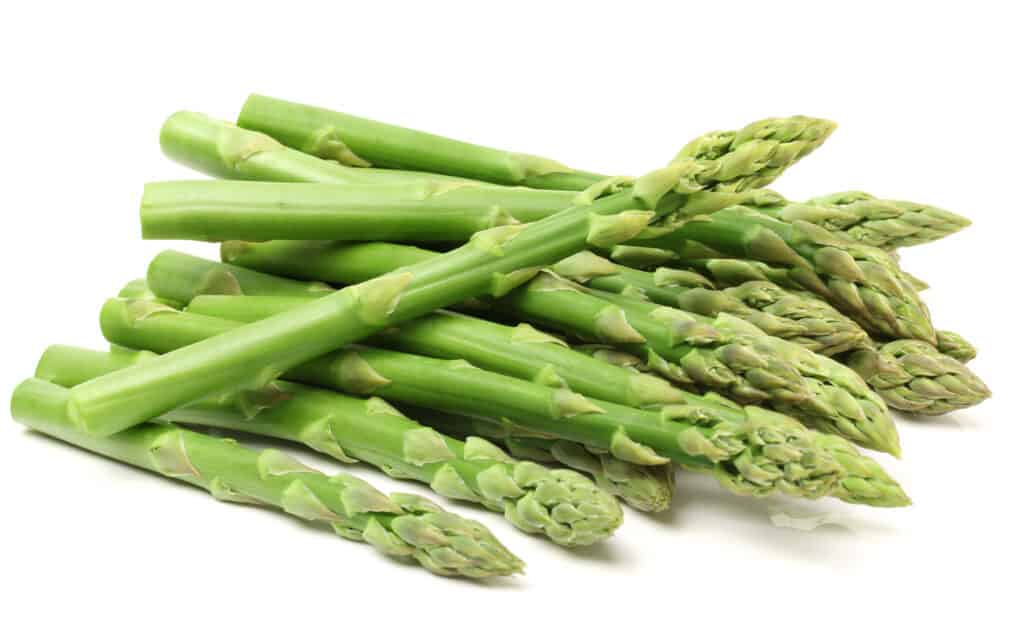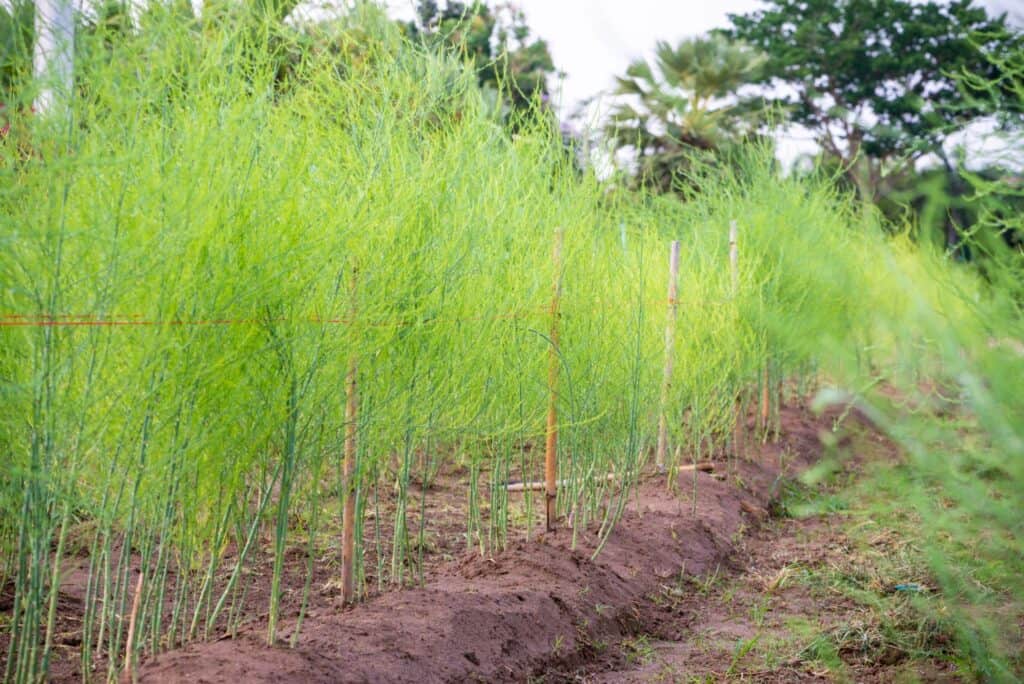Asparagus is a unique vegetable with an infamous aroma, woody texture, and earthy taste. While green asparagus is common in North America, white asparagus is the preferred alternative in European cuisine. Most people don’t know that green and white asparagus are the same plant. The differences lie in how they’re planted and harvested. So, white asparagus vs. green asparagus: here are the notable differences between green and white asparagus and how to grow both.

White asparagus and green asparagus are the same plants. They’re not a different cultivar or variety; white asparagus is green asparagus.
©zcw/Shutterstock.com
Comparing White Asparagus vs. Green Asparagus
| White Asparagus | Green Asparagus | |
|---|---|---|
| Classification | Asparagus officinalis | Asparagus officinalis |
| Alternative Names | Ghost asparagus | Garden asparagus, Sparrow grass |
| Origin | Europe | Europe, Western Asia |
| Description | Green, perennial, woody vegetable growing in vertical stalks up to 7 feet tall (though harvested at 6-12″). It will sprout feathery green foliage if left to go to seed. | Asparagus is one of the few perennial vegetables. One asparagus patch can last for 15 growing seasons if cared for properly. |
| Uses | This unique, nutrient-rich vegetable is primarily used for culinary purposes. | This nutrient-rich vegetable is primarily used for culinary purposes. |
| Growth Tips | Plant crowns roots down in weed-free soil after the risk of frost. Cover with at least 6″ of soil. Add more soil as initial growth appears. Continue adding soil as the shoots appear, creating a mound. Consider an additional cover (black plastic plant tunnel or wooden box). | Plant crowns roots down in weed-free soil after the risk of frost. Cover with at least 6″ of soil. Add more soil as initial growth appears. Cover in mulch and ensure consistent moisture until harvest. |
| Interesting Features | White asparagus is the same plant as green asparagus. The lack of sun exposure eliminates chlorophyll production, which gives it a ghostly white appearance. | Asparagus is one of the few perennial vegetables. One asparagus patch can last for 15 growing seasons if cared for properly. |
| Flavor Profile | Mild, delicate, sweet | Vegetal, earthy, bittersweet |
Key Differences Between White Asparagus vs. Green Asparagus
White asparagus and green asparagus are the same plants. They’re not a different cultivar or variety; white asparagus is green asparagus.
The difference is how the plant is grown and harvested. White asparagus is shielded from the sun for the duration of its growing cycle. Plants undergo a process called photosynthesis, in which they absorb nutrients from the sun. As chlorophyll absorbs blue light and red-light waves from the sun, it reflects green light. It’s this aspect that gives plants their green color.
Gardeners plant established (green) asparagus crowns, then meticulously keep them covered and hidden from the sun as they grow. If they were left unchecked, the spears would turn green.
This process has created subtle differences in texture and flavor. White asparagus is less woody and has a milder flavor. While it still has the subtle bitter notes of green asparagus, they’re less pronounced.
White Asparagus vs. Green Asparagus: Classification
White asparagus and green asparagus are both the species Asparagus officinalis. The Asparagus genus is also home to 300 other species of perennial, woody plants. Asparagus officinalis is the only edible species, with most others growing in the wild or ornamental gardens.

Asparagus grows tall
when going to seed
!
©Yongkiet Jitwattanatam/Shutterstock.com
White Asparagus vs. Green Asparagus: Origin
White asparagus and green asparagus both originated in Europe, with green asparagus extending into Asia.
France, Italy, and Germany claim the credit for “inventing” white asparagus. Given the proximity of the countries and the uncertainty of the time period, we’ll likely never know its exact origins.
According to the lore, a freak hailstorm in the 1600s was damaging crops, so the farmers covered the asparagus in the dirt to protect it. When they harvested it months later, it was white, sweet, and delicate. They continued using this method going forward.
White Asparagus vs. Green Asparagus: Description
Both white and green asparagus grow from crowns in vertical stalks. If left unharvested, asparagus will grow up to seven feet tall and sprout feathery, green foliage, rendering it inedible. This is common in the wild. Both have woody stalks with a short, feathery spear at the top.
Both white and green asparagus are harvested when the stalks reach 6-12″ high. Harvesting too early results in more bitterness when eaten.
While white and green asparagus are the same plant, the flavor has subtle differences. White asparagus is treated as a delicacy in fine dining due to its palatability and high-maintenance growth requirements. The flavor is milder in white asparagus and sweeter than its green counterpart.
White Asparagus vs. Green Asparagus: Uses
Both white and green asparagus are primarily used for cooking. White asparagus is more common in Europe and in fine dining dishes. Green asparagus is more popular in North America and more commonplace in day-to-day cuisine.
Wild green asparagus was also used in ancient Chinese medicine. This application is unsurprising as asparagus is high in nutrient value.
White Asparagus vs. Green Asparagus: Growth Tips
Asparagus is one of the few perennial vegetables. Choosing the right planting location is essential, as well-rooted asparagus crowns can produce crops for up to 15 years. Asparagus is a high-maintenance plant and has no weed resilience — the soil must be completely eradicated of weeds for asparagus to survive.
To grow green asparagus, dig a trench 12-18″ deep with a mound in the middle after the risk of frost has passed. Lay crowns roots down on the mound, draping the roots over either side. Cover with soil until the crown is at least 6″ under. Add more soil as initial growth appears. Cover in mulch and ensure consistent moisture until harvest. Harvest when stalks are 6-10 inches high; an earlier harvest will yield sweeter results.
To grow white asparagus, use established crowns that have been successfully harvested for two or more years. Follow the same steps for planting. Continue to apply more soil as the sprouts grow, keeping the soil evenly moistened. Adding a black plastic plant tunnel or sturdy wooden box can help keep sprouts hidden from the sun. Harvest when stalks are 6-10 inches high; an earlier harvest will yield sweeter results.

While white and green asparagus are the same plant, the flavor has subtle differences.
©DUSAN ZIDAR/Shutterstock.com
The photo featured at the top of this post is © iMarzi/Shutterstock.com
Thank you for reading! Have some feedback for us? Contact the AZ Animals editorial team.






